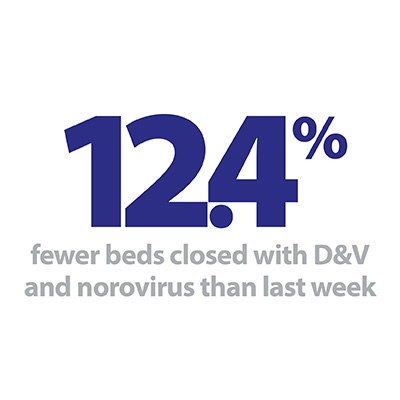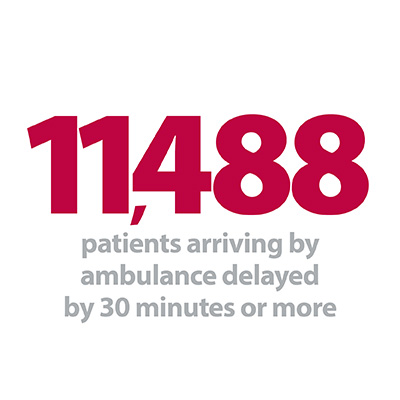


The penultimate week of the 2019/20 winter sitreps data paints a somewhat encouraging picture. However with snow and seasonal weather ahead, and the threat of coronavirus looming, trusts are still managing significant operational risk. The small but positive improvements in most indicators from last week are testament to the hard work of staff at a time of sustained, high demand.
Key headlines from week 12 sitreps:
- Bed occupancy is 93.7%, still very high but slightly down for the third week in a row.
- Length of stay saw small reductions in the number of patients staying more than 7, 14 and 21 days this week, but these all remain higher than last year.
- Ambulance arrivals were slightly down this week and are now 6.1% lower than the peak level earlier in the winter (878 fewer arrivals per day). They are also below the level seen at the same point last year.
- Ambulance handover delays improved slightly on last week, but there were still 1,641 patients delayed by 30 minutes or more each day (12.1% of all arrivals), and 284 were delayed by 60 minutes or more each day (2.1% of all arrivals).
- Beds closed with D&V and norovirus fell by 12.4% this week to 507 (72 fewer beds). While this figure does fluctuate more than most indicators, this is now the second lowest weekly total this winter.
We again saw a reduction in bed occupancy this week, but the current figure of 93.7% is higher than the 92% limit identified in the 2020/21 planning guidance. The number of patients staying longer than 7, 14 and 21 days also fell slightly in week 12, but with more people staying longer than last year it is clear trusts remain under pressure from elevated demand.
Trusts have also made positive steps to improve patient flow and streamline services.
On the positive side, there are significantly fewer ambulance arrivals than earlier in the winter, and fewer patients are having their handovers delayed when they reach hospital. Similarly, the number of beds closed with D&V and norovirus remains under control, with this week’s total lower than all weeks but one over the winter so far. Trusts have also made positive steps to improve patient flow and streamline services.
However, the number of staff vacancies across the NHS remains stubbornly around the 100,000 mark. While endeavours to grow the total workforce are having some effect, it remains a concern that such a high proportion of posts cannot be filled particularly at a time of such pressure on operational services. We know that trusts are particularly worried about the wellbeing of their staff within this context.
While there is only one further week of the official winter reporting period to come, trusts will be bracing themselves for an ongoing battle to provide high levels of care, particularly if cold weather continues or there is a significant increase in cases of coronavirus. We continue to call for greater investment in social care and community services to ensure that people can be safely treated in the most appropriate place, which in turn will help ease the burden on ambulance and acute services in times of peak demand.
In this week's contributor blog from North East London NHS Foundation Trust (NELFT) we hear from Anne Motley, assistant director, inpatients and unplanned care and Rita Thakaria, assistant director, community and crisis care, adult services, who give insights on the way their teams work across mental health and community services and in partnership and integration with other agencies.
Treating people closer to home where appropriate this winter
How innovate schemes are helping mitigate winter pressures
Anne Motley, NELFT assistant director of inpatients and unplanned care, highlights how innovative schemes have been implemented by teams to help alleviate increased demand pressures over winter.
Early preparations for winter pressures this year have resulted in our teams responding to the increased demand with a number of innovative schemes. Some of these have been funded through the better care fund whilst others have been created through partnership and integration with other agencies. We have seen an increase in attendances into Basildon and Thurrock University Hospital (BTUH) A&E overall by 9%, and frailty attendances have also increased. One of the schemes we have been involved in is to provide a NELFT navigator to work with the frailty team in BTUH to support the "home first" agenda. With a full knowledge of community services the navigator has been able to liaise directly with our community teams to support elderly people to go home rather than have an unnecessary admission into a hospital bed. The work of the navigator is to be the NELFT contact for the hospital and to respond to the demands placed upon the hospital when capacity and demand are high.
Our community beds based in Thurrock and Brentwood provide both a step up and step down facility for those patients requiring intermediate care, offering time to build strength and independence and complete any necessary acute care and treatment. As demand has increased over the winter period the average length of stay has reduced with over 50% of patients completing their care with an average length of stay of less than 21 days. Despite workforce challenges particularly around allied health care professionals, teams have adopted core discharge principals by implementing red to green day methodology, daily board rounds, the practice of predicted discharge dates and an overall motivation to work as a team to support our patients towards individual goal setting and recovery. Readmission rates to our units are below the national target and we see the majority of our patients discharged to their own home with very few transferring to care homes.
For the first few weeks in January, community nurses from our crisis teams and intensive rehabilitation service formulated a rota to introduce a more consistent presence in BTUH emergency department, and this covered both weekdays and weekends. As a result of this initiative we were able to facilitate a number of discharges from the emergency department – and we look to have this same scheme next year.
Numbers of referrals have increased this year demonstrating the commitment, effectiveness and hard work of the team.

The intensive rehabilitation team have supported patients in their own homes to achieve independence and recovery. This service has gone from strength to strength since it was set up over three years ago to provide an alternative to bed-based rehabilitation. Patients are identified by BTUH colleagues, local community staff and GPs with the majority of referrals coming from acute partners in BTUH, Barking, Havering and Redbridge University Hospitals NHS Trust and Mid Essex. Numbers of referrals have increased this year demonstrating the commitment, effectiveness and hard work of the team. Early discussions with our local reablement provider Essex Cares LTD, has opened up opportunities to think more collaboratively about how we provide both services to our local population, and we are planning to progress this over the coming months along with the Essex County Council Newton Europe diagnostic work (a consultation company who have undertaken an assessment of intermediate care across Essex).
Staff have worked incredibly hard over the winter period and continue to do so. Despite the increase in demand, workforce challenges and increasing acuity and complexity of staff, opportunities are beginning to emerge across the system around the provision of integrated services through social care, other community providers and the MSE group (Mid Southend and Basildon Trusts) building on these opportunities over the coming year will look towards a more efficient and effective service.
Triaging 999 calls to provide care in the community
Rita Thakaria, NELFT assistant director of community and crisis care, describes how the community treatment team are supporting and empowering patients maintain independence and be treated closer to home.
The project works in partnership with East of England Ambulance Service Trust to base clinicians from NELFT, PROVIDE and Essex Partnership University NHS Foundation Trust, working as part of a multi-disciplinary community team, in the ambulance hub triaging category 2, 3 and 4 emergency 999 calls. Where clinically appropriate, a member of the multi-disciplinary community team back in the locality can attend to assess the patient and, where possible, provide an alternative package of care.
The service supports and empowers patients to remain at home or in another community setting by optimising the individual's level of function by maximising independence. The service provides timely multi-disciplinary assessment and intervention to reduce the number of patients conveyed to A&E by ambulance or admitted to acute hospitals by rapidly mobilising community services.
The service supports and empowers patients to remain at home or in another community setting by optimising the individual’s level of function by maximising independence.
The initial phase over the summer period showed approximately 89% of patients are believed to have remained at home, all patients received treatment within three and a half hours of their 999 call with a conservative estimate of £65,000 cost savings to the system. Following successful presentations to the Mid and South Essex Health and Care Partnership and local A&E boards, the programme was extended as part of winter monies and NHS England ageing well initiatives from December 2019 – March 2020. The funding has allowed for additional staffing, training and equipment to support patients effectively and safely in their own home.
During this period, a full business case is being developed that sets out the optimal model of service provision and the requirements to implement the optimal model.
We need an urgent action plan for social care to help mitigate winter pressures
Responding to the latest weekly winter reporting data published by NHS England and NHS Improvement, the director of policy and strategy at NHS Providers, Miriam Deakin said:
"This week we have seen NHS performance improve slightly compared to recent weeks, which is a real testament to the efforts of frontline staff. It is encouraging to see that the number of people arriving by ambulances at hospitals has fallen below last year’s levels, and there have been fewer delays in admitting patients to hospital than last week.
"However we must not become complacent. Although we have seen an improvement this week, the number of people occupying a hospital bed is still higher than recommended and pressures are still mounting with the prospect of snow and seasonal weather ahead.
"Trust are also working hard to test potential cases of coronavirus. The NHS is well prepared to deal with an uptake in cases of the virus, but extra resources are needed to support people concerned they may have the disease and to ensure that day-to-day services are not affected.
"Within this context of rising demand, figures released today also confirm that the NHS is still coping with 100,000 staff vacancies. We also need to see an urgent action plan for social care, particularly given that proposed changes to the immigration system are likely to affect the recruitment of staff. This is vital to ensure we have a sustainable health and care system, working hand-in-hand."